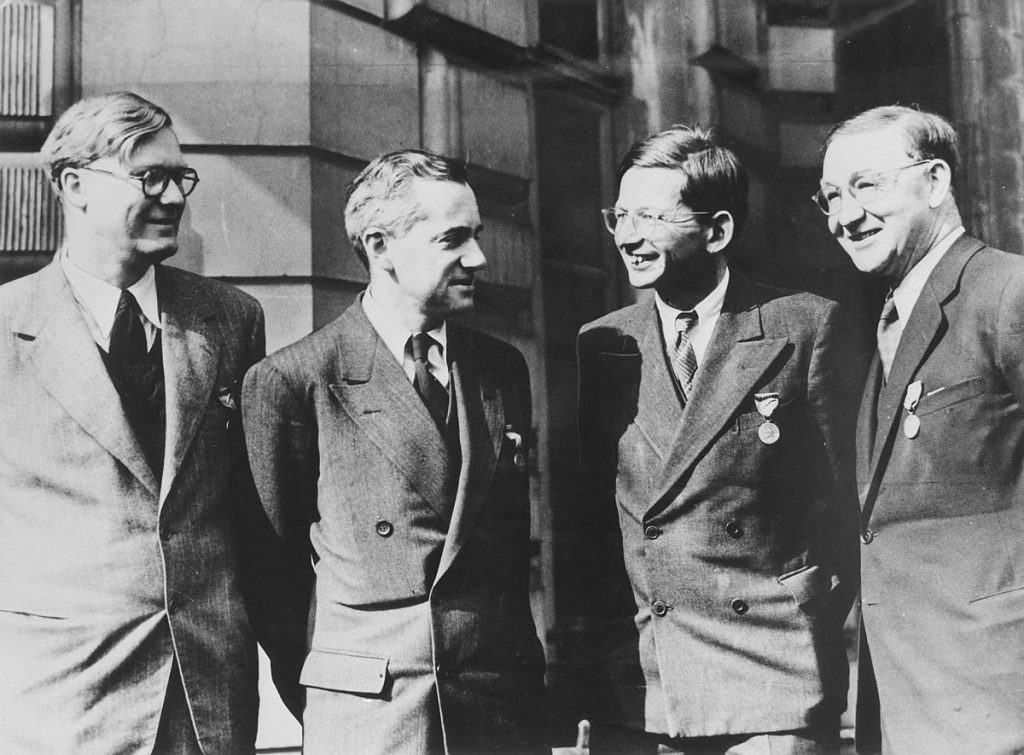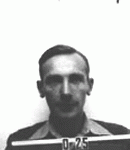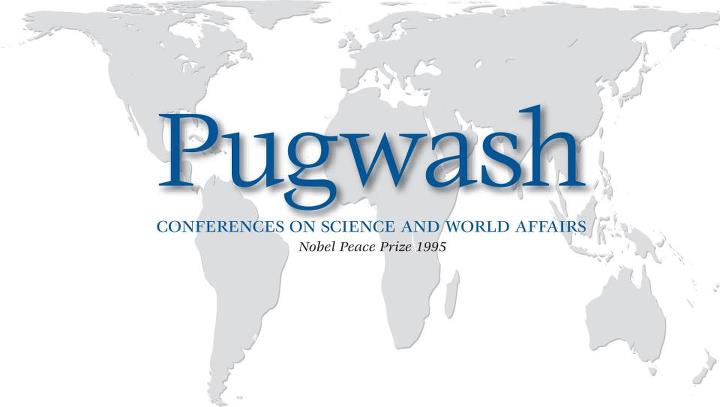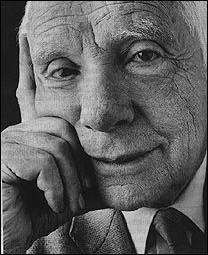I always believed that science should be used in service of mankind. The notion of utilizing my knowledge to produce an awesome weapon of destruction was abhorrent to me. –Joseph Rotblat, Bulletin of the Atomic Scientists, 1985
Joseph Rotblat was born in Warsaw, Poland in 1908 to a middle-class Jewish family. In the aftermath of World War I, Rotblat’s family could not afford to send him to secondary school. Instead, he attended a Jewish technical school and earned an electrician’s diploma. Rotblat entered the field of nuclear physics in 1929, after being admitted into the Free University of Poland in Warsaw, where he studied under the Director of the Radiological Laboratory of Warsaw, Ludwik Wertenstein.[1]
Despite his concerns about impending war, in April 1939 Rotblat accepted a year-long fellowship under the direction of James Chadwick in Liverpool, England. They conducted research on the inelastic scattering of neutrons using a cyclotron. Due to a medical procedure, Rotblat’s wife, Tola Gryn, stayed behind in Warsaw with plans to follow after she recovered. Unfortunately, by the time Rotblat arrived in Liverpool, Hitler had invaded Poland. Until the spring of 1945, Rotblat received no word about the fate of his family.
Liverpool
The announcement of the discovery of nuclear fission early in 1939 inspired Rotblat to hypothesize about a nuclear chain reaction that would release incredible amounts of energy. The potential of creating a powerful nuclear weapon haunted Rotblat as World War II began. He remembered his dilemma in a 1989 interview with historian Martin J. Sherwin: “From the very beginning, I was afraid of the Germans. I gradually worked out this rationale of deterrence. But even then, I was not convinced that I should really work [on this research]. So, this was a tumor which had been growing. Difficult to imagine this sort of torture, the mental torture of whether I should do something about it or not.”
By November, Rotblat’s fear that German scientists were developing an atomic weapon outweighed his apprehension. He asked Chadwick for permission to pursue research.[2] Although many other physicists had conceived of the possibility of an atomic weapon, Rotblat’s early research contributed to its becoming a reality and his later feelings of guilt: “Maybe because of this that I felt an extra responsibility, a little bit more than the other people who were recruited by others.”
 After receiving authorization from Chadwick, Rotblat began his research. Unbeknownst to him, fellow emigre scientists Otto Frisch and Rudolf Peierls (pictured, second and third from left) were also working independently on the question. In 1940, they published the Frisch-Peierls Memorandum, concluding that producing a super-weapon was likely. British scientists formed what was called the MAUD Committee in March 1940 to discuss their confidential research. In 1941, the committee issued the MAUD Committee Report, estimating the amount of money and material needed for an atomic weapon and recommending collaboration between the United States and Britain. Rotblat participated in this research under Chadwick’s direction, but was not informed of the existence of the MAUD Committee because he was not a British citizen.
After receiving authorization from Chadwick, Rotblat began his research. Unbeknownst to him, fellow emigre scientists Otto Frisch and Rudolf Peierls (pictured, second and third from left) were also working independently on the question. In 1940, they published the Frisch-Peierls Memorandum, concluding that producing a super-weapon was likely. British scientists formed what was called the MAUD Committee in March 1940 to discuss their confidential research. In 1941, the committee issued the MAUD Committee Report, estimating the amount of money and material needed for an atomic weapon and recommending collaboration between the United States and Britain. Rotblat participated in this research under Chadwick’s direction, but was not informed of the existence of the MAUD Committee because he was not a British citizen.
On August 19, 1943, President Franklin D. Roosevelt and Prime Minister Winston Churchill signed the Quebec Agreement, which stipulated the terms of nuclear cooperation between the United States and England. Prominent British scientists were to be transferred to the Manhattan Project sites. Each person on the “British Mission” was required to become a citizen of Great Britain. While Frisch, Klaus Fuchs, and Peierls were granted overnight citizenship, Rotblat refused to renounce his Polish citizenship. He considered it his duty to return to his home country after the war and re-establish science education, since many of his former colleagues had been murdered. He remained behind in Liverpool while his team left for Los Alamos in 1943. Within the following two weeks, Chadwick notified Rotblat that General Leslie Groves had made an exception, and he departed for Los Alamos in January 1944.
Los Alamos and the Manhattan Project
 Upon arriving in Los Alamos, Rotblat lived with Chadwick and worked under Robert Bacher investigating high-energy gamma radiation.[3] He was later transferred to the cyclotron division, where he accidentally became exposed to 150 rads of mixed neutron and gamma radiation, leaving him severely ill for days afterwards. Rotblat attended the weekly colloquia between scientists, the administrative meetings with the Coordinating Council, and dinner parties at Oppenheimer’s home.
Upon arriving in Los Alamos, Rotblat lived with Chadwick and worked under Robert Bacher investigating high-energy gamma radiation.[3] He was later transferred to the cyclotron division, where he accidentally became exposed to 150 rads of mixed neutron and gamma radiation, leaving him severely ill for days afterwards. Rotblat attended the weekly colloquia between scientists, the administrative meetings with the Coordinating Council, and dinner parties at Oppenheimer’s home.
Rotblat struggled with the ethics of the Project throughout his time at Los Alamos. However, two main factors precipitated his decision to leave. The first emerged while sitting at the Chadwicks’ dinner table with General Groves in March 1944. According to Rotblat, Groves declared that the true purpose of the atomic bomb was to subdue the Soviet Union. Although Rotblat was aware of the tensions between the Soviet Union and United States, he was shocked at what he considered a cavalier betrayal of an ally. Secondly, in discussions with Niels Bohr, Rotblat realized that the development of atomic weapons would likely result in a nuclear arms race. The final straw came when it became apparent that the Germans had abandoned their nuclear program. In late 1944, Rotblat requested to leave the Project and return to England.
Rumors swirled about the real reason Rotblat left the Manhattan Project. Before he was officially granted dispensation, Army Intelligence compiled a dossier asserting Rotblat was a Soviet agent. The Army viewed his frequent visits to Elspeth Bobbs in Santa Fe and his desire to return to Soviet-occupied Poland with suspicion. As Rotblat recalled, “They made it out the reason why I decided to go back is because I wanted to go back first to England, then somehow be flown from England across the Polish—Poland was occupied by the Russians, drop by parachute, that sort of thing—all in order to give all the secrets away to the Russians.” While Rotblat had alibis to refute claims of espionage, in the course of his voyage to England in December, a trunk containing his notes, correspondence, and scientific papers disappeared. Some suspect that the security chief at Los Alamos, Captain Peer de Silva, confiscated the trunk to ensure the papers did not end up in Soviet hands.
After the Manhattan Project
Rotblat returned to Britain and was appointed to supervise the reconstruction of cyclotrons at Liverpool and Cambridge. In March 1945, he received a letter from his brother-in-law, Mieszyslaw, with news about their family. Tola and her mother had been rounded up by the Nazis and murdered in the Belzec extermination camp. In order to help his surviving family members escape Poland, Rotblat finally applied for British citizenship.
After the atomic bombings of Hiroshima and Nagasaki, Rotblat was determined to prevent the development of future nuclear weapons. He was haunted by his own role in the creation of the atomic bombs and devoted the rest of his life to protesting nuclear testing and weapons production. He switched his scientific focus to the medical applications of nuclear physics and the viability of radiation as a treatment for cancer.
Rotblat was active in international disarmament programs and efforts to educate the public and scientific community. He helped establish organizations devoted to nuclear education and regulation, such as the Atomic Scientists’ Association of the United Kingdom, the “Atom Train” exhibit that toured the UK with information about nuclear energy, and the Pugwash Conferences on Science and World Affairs.
 Born out of the 1955 manifesto issued by Bertrand Russell and Albert Einstein–and signed by Max Born, Percy Bridgman, Leopold Infeld, Frederic Joliot-Curie, Herman Muller, Linus Pauling, Cecil Powell, Hideki Yukawa, and Rotblat–the Pugwash Conferences invited scientists worldwide to discuss the threat to society posed by weapons of mass destruction. Rotblat helped organize the first meeting, held in Pugwash, Nova Scotia, Canada in 1957. The organization continues to meet internationally to inspire dialogue among scientists. In 1995, the Pugwash Conferences and Rotblat jointly received the Nobel Peace Prize for their work towards total nuclear disarmament.
Born out of the 1955 manifesto issued by Bertrand Russell and Albert Einstein–and signed by Max Born, Percy Bridgman, Leopold Infeld, Frederic Joliot-Curie, Herman Muller, Linus Pauling, Cecil Powell, Hideki Yukawa, and Rotblat–the Pugwash Conferences invited scientists worldwide to discuss the threat to society posed by weapons of mass destruction. Rotblat helped organize the first meeting, held in Pugwash, Nova Scotia, Canada in 1957. The organization continues to meet internationally to inspire dialogue among scientists. In 1995, the Pugwash Conferences and Rotblat jointly received the Nobel Peace Prize for their work towards total nuclear disarmament.
Joseph Rotblat passed away on August 31, 2005. To the end of his life, he believed scientists have personal responsibility for their inventions. In 1998, Rotblat was knighted under the Order of St. Michael and St. George. He is remembered internationally for commitment to peace. In his Nobel Peace Prize acceptance speech, Rotblat implored: “Above all, remember your humanity.”
Historical Sources:
Pugwash Conferences on Science and World Affairs
Brown, Andrew. Keeper of the Nuclear Conscience: The Life and Work of Joseph Rotblat. Oxford: Oxford University Press, 2012.
Rotblat, Joseph. “Leaving the Bomb Project.” Bulletin of the Atomic Scientists 41, no. 7 (1985): 16-19. doi:10.1080/00963402.1985.11455991.
Rotblat, Joseph. “Remember Your Humanity.” Social Alternatives 15, no. 3 (July 1996): 50–53.





